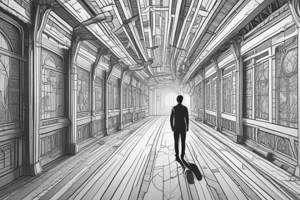Podcast
Questions and Answers
Perspective drawing allows artists to create two-dimensional representations of scenes.
Perspective drawing allows artists to create two-dimensional representations of scenes.
False (B)
In perspective drawing, objects appear larger as they recede into the distance.
In perspective drawing, objects appear larger as they recede into the distance.
False (B)
The vanishing point in perspective drawing represents where parallel lines meet in the distance.
The vanishing point in perspective drawing represents where parallel lines meet in the distance.
True (A)
The vertical line of sight in perspective drawing indicates the height at which an object would be visible.
The vertical line of sight in perspective drawing indicates the height at which an object would be visible.
One Point Perspective is often used in landscapes and natural scenes.
One Point Perspective is often used in landscapes and natural scenes.
The horizontal line of sight in perspective drawing is also known as the eye level.
The horizontal line of sight in perspective drawing is also known as the eye level.
Two Point Perspective is used for drawing simple structures like a single window
Two Point Perspective is used for drawing simple structures like a single window
Three Point Perspective is mainly used for drawing portraits
Three Point Perspective is mainly used for drawing portraits
Artists can only choose between realism or surrealism when applying perspective principles
Artists can only choose between realism or surrealism when applying perspective principles
Tomasz Alen Kopera used traditional one point perspective to create a realistic Mondrian painting
Tomasz Alen Kopera used traditional one point perspective to create a realistic Mondrian painting
Chris Hajny creates abstract digital renderings without any basis in classical perspective techniques
Chris Hajny creates abstract digital renderings without any basis in classical perspective techniques
Learning perspective drawing only benefits those aiming for realistic accuracy
Learning perspective drawing only benefits those aiming for realistic accuracy
Flashcards are hidden until you start studying
Study Notes
Perspective Drawing
Perspective drawing is an essential technique used by artists to create three-dimensional representations of scenes on a two-dimensional surface. It allows painters, architects, designers, and other visual artists to convey depth, distance, size, and shape more accurately. In this form of artistic representation, objects appear smaller as they recede into the distance, following mathematical rules known as linear perspective.
Overview
To understand perspective drawing, it's vital to grasp several key concepts:
- Vanishing Point: This point represents where parallel lines intersect when seen from a specific viewpoint. This helps in creating the illusion of depth on a flat surface.
- Horizontal Line of Sight: Also called the horizon line or eye level, it indicates the height at which an object would be visible if you were standing at your chosen vantage point.
- Vertical Line of Site: Perpendicular to the horizontal line of sight, it determines how objects move up and down relative to one another within the scene being depicted.
Techniques
There are different techniques used in perspective drawing depending on the desired effect. Some common ones include:
- One Point Perspective: When all verticals converge towards a single vanishing point on the horizon, this form of perspective is used; often found in cityscapes and buildings.
- Two Point Perspective: Used when more complex structures need to be drawn, like rooms with many windows and doors. Here, both vertical and horizontal lines converge at distinct points.
- Three Point Perspective: Often used for landscapes, this method involves placing the horizon line above or below the center of the canvas, allowing for even more flexibility in composition.
Realism vs. Abstraction
Artists can choose between traditional realism or abstract interpretations of reality when applying perspectives principles. For instance, Tomasz Alen Kopera has presented a version of a Mondrian painting using traditional one point perspective drawing rules while still maintaining the essence of abstract art. Likewise, Chris Hajny, a programmer turned artist, creates intricate digital renderings based on geometric principles, giving his work a distinctly abstract feel despite its basis in classical perspective techniques.
In conclusion, whether you're looking to capture the world around us with realistic accuracy or push the boundaries of what we perceive as real through abstraction, learning the nuances of perspective drawing opens up new possibilities in creative expression.
Studying That Suits You
Use AI to generate personalized quizzes and flashcards to suit your learning preferences.




